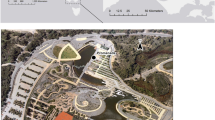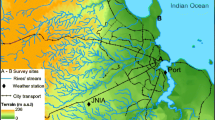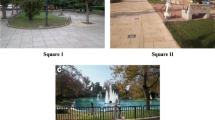Abstract
Outdoor thermal comfort studies have mainly examined the perception of local residents, and there has been little work on how those conditions are perceived differently by tourists, especially tourists of diverse origins. This issue is important because it will improve the application of thermal indices in predicting the thermal perception of tourists. This study aims to compare the differences in thermal perception and preferences between local and overseas visitors to the Royal Botanic Garden (RBG) in Melbourne during summer. An 8-day survey was conducted in February 2014 at four sites in the garden (n = 2198), including 2 days with maximum temperature exceeding 40 °C. The survey results were compared with data from four weather stations adjacent to the survey locations. One survey location, ‘Fern Gully’, has a misting system and visitors perceived the Fern Gully to be cooler than other survey locations. As the apparent temperature exceeded 32.4 °C, visitors perceived the environment as being ‘warm’ or ‘hot’. At ‘hot’ conditions, 36.8 % of European visitors voted for no change to the thermal conditions, which is considerably higher than the response from Australian visitors (12.2 %) and Chinese visitors (7.5 %). Study results suggest that overseas tourists have different comfort perception and preferences compared to local Australians in hot weather based at least in part on expectations. Understanding the differences in visitors’ thermal perception is important to improve the garden design. It can also lead to better tour planning and marketing to potential visitors from different countries.











Similar content being viewed by others

References
Alexander LV, Arblaster JM (2009) Assessing trends in observed and modelled climate extremes over Australia in relation to future projections. Int J Climatol 29(3):417–435
Andrade H, Alcoforado M-J, Oliveira S (2011) Perception of temperature and wind by users of public outdoor spaces: relationships with weather parameters and personal characteristics. Int J Biometeorol 55(5):665–680
Bacci L, Morabito M, Raschi A, Ugolini F (2003) Thermohydrometric conditions of some urban parks of Florence (Italy) and their effects on human well-being. Paper presented at The Fifth International Conference on Urban Climate, Lodtz, Poland, 1–5 September, 2003
Barradas VL (1991) Air temperature and humidity and human comfort index of some city parks of Mexico City. Int J Biometeorol 35(1):24–28
Bowler DE, Buyung-Ali L, Knight TM, Pullin AS (2010) Urban greening to cool towns and cities: A systematic review of the empirical evidence. Landscape Urban Plann 97(3):147–155
Bränström R, Brandberg Y, Holm L, Sjöberg L, Ullen H (2001) Beliefs, knowledge and attitudes as predictors of sunbathing habits and use of sun protection among Swedish adolescents. Eur J Cancer Prev 10(4):337–345
Bröde P, Fiala D, Baejczyk K, Holmér I, Jendritzky G, Kampmann B, Tinz B, Havenith G (2012) Deriving the operational procedure for the Universal Thermal Climate Index (UTCI). Int J Biometeorol 56(3):481–494
Cancer Council Victoria (2015) Ten years on: ‘Bronzed Aussie’ aspiration a thing of the past. Cancer Council Victoria. http://www.cancervic.org.au/about/media-releases/2015-media-releases/january-2015/ten-years-on-bronzed-aussie-aspiration-thing-of-the-past.html. Accessed 30 November 2015
Chang CR, Li MH, Chang SD (2007) A preliminary study on the local cool-island intensity of Taipei city parks. Landscape Urban Plann 80(4):386–395
Chen L, Ng E (2012) Outdoor thermal comfort and outdoor activities: a review of research in the past decade. Cities 29(2):118–125
de Abreu-Harbich LV, Labaki LC, Matzarakis A (2015) Effect of tree planting design and tree species on human thermal comfort in the tropics. Landscape Urban Plann 138:99–109
de Boer J, van Es A, Voorrips L, Blokstra F, Vogt J (1988) Energy metabolism and requirements in different ethnic groups. Eur J Clin Nutr 42(12):983–997
de Dear R, Fountain M (1994) Field experiments on occupant comfort and office thermal environments in a hot-humid climate. ASHRAE Trans 100:457–474
de Freitas CR (2003) Tourism climatology: evaluating environmental information for decision making and business planning in the recreation and tourism sector. Int J Biometeorol 48(1):45–54
Dobbinson SJ, Volkov A, Wakefield MA (2015) Continued Impact of SunSmart Advertising on Youth and Adults’ Behaviors. Am J Prev Med 49(1):20–28
Eliasson I (2000) The use of climate knowledge in urban planning. Landscape Urban Plann 48(1):31–44
Eliasson I, Knez I, Westerberg U, Thorsson S, Lindberg F (2007) Climate and behaviour in a Nordic city. Landscape Urban Plann 82(1–2):72–84
Gómez Martín MB (2005) Weather, climate and tourism a geographical perspective. Ann Tourism Res 32(3):571–591
Havenith G (2001) Human surface to mass ratio and body core temperature in exercise heat stress—a concept revisited. J Therm Biol 26(4–5):387–393
Havenith G (2005) Temperature regulation, heat balance and climatic stress. In: Extreme weather events and public health responses. Springer, Berlin Heidelberg, pp 69–80
IBM Corp. (2012) IBM SPSS Statistics for Windows, Version 21.0. IBM Corp., Armonk, NY
International Labour Organization (1998) Safe Work Bookshelf. ILO, Geneva
Irmak MA, Yi̇lmaz S, Yi̇lmaz H, Ozer S, Toy S (2013) Evaluation of different thermal conditions based on THI under different kind of tree types—as a specific case in ata botanic garden in eastern Turkey. Global NEST J 15(1):131–139
Jonsson P (2004) Vegetation as an urban climate control in the subtropical city of Gaborone, Botswana. Int J Climatol 24(10):1307–1322
Karjalainen S (2012) Thermal comfort and gender: a literature review. Indoor Air 22(2):96–109
Kenawy I, Elkadi H (2013) The impact of cultural and climatic background on thermal sensation votes. Paper presented at the PLEA2013 - 29th Conference, Sustainable Architecture for a Renewable Future, Munich, Germany, 10–12 September 2013
Knez I, Thorsson S (2006) Influences of culture and environmental attitude on thermal, emotional and perceptual evaluations of a public square. Int J Biometeorol 50(5):258–268
Lafortezza R, Carrus G, Sanesi G, Davies C (2009) Benefits and well-being perceived by people visiting green spaces in periods of heat stress. Urban For Urban Green 8(2):97–108
Lin T-P (2009) Thermal perception, adaptation and attendance in a public square in hot and humid regions. Build Environ 44(10):2017–2026
Lin T-P, de Dear R, Hwang R-L (2011) Effect of thermal adaptation on seasonal outdoor thermal comfort. Int J Climatol 31(2):302–312
Lin T-P, Tsai K-T, Liao C-C, Huang Y-C (2013) Effects of thermal comfort and adaptation on park attendance regarding different shading levels and activity types. Build Environ 59:599–611
Liu Y, Wang L, Di Y, Liu J, Zhou H (2013) The effects of clothing thermal resistance and operative temperature on human skin temperature. J Therm Biol 38(5):233–239
Loughnan M, Tapper NJ, Coutts AM, Beringer J (2012) Identifying summer temperature ranges for human thermal comfort in two Australian cities. Paper presented at the 7th International Conference on Water Sensitive Urban Design, Melbourne Cricket Ground, Melbourne, Australia, 21–23 February
Lundgren K, Kuklane K, Gao C, Holmér I (2013) Effects of heat stress on working populations when facing climate change. Ind Health 51:3–15
Makin JK, Warne CD, Dobbinson SJ, Wakefield MA, Hill DJ (2013) Population and age-group trends in weekend sun protection and sunburn over two decades of the SunSmart programme in Melbourne, Australia. Br J Dermatol 168(1):154–161
Matzarakis A, Mayer H (1996) Another kind of environmental stress: thermal stress. WHO News 18:7–10
Mishra AK, Ramgopal M (2013) Field studies on human thermal comfort—an overview. Build Environ 64:94–106
Murray D, Price B, Crilley G (2007) Advocacy and visitation levels in Australian botanic gardens: process and outcome benefits. J Park Recreat Adm 25(3):67–88
Nikolopoulou M, Lykoudis S (2006) Thermal comfort in outdoor urban spaces: analysis across different European countries. Build Environ 41(11):1455–1470
Nikolopoulou M, Steemers K (2003) Thermal comfort and psychological adaptation as a guide for designing urban spaces. Energy Build 35(1):95–101
Nikolopoulou M, Baker N, Steemers K (2001) Thermal comfort in outdoor urban spaces: understanding the human parameter. Sol Energy 70(3):227–235
Oliveira S, Andrade H (2007) An initial assessment of the bioclimatic comfort in an outdoor public space in Lisbon. Int J Biometeorol 52(1):69–84
Oliveira S, Andrade H, Vaz T (2011) The cooling effect of green spaces as a contribution to the mitigation of urban heat: a case study in Lisbon. Build Environ 46(11):2186–2194
Pantavou K, Theoharatos G, Santamouris M, Asimakopoulos D (2013) Outdoor thermal sensation of pedestrians in a Mediterranean climate and a comparison with UTCI. Build Environ 66:82–95
Parsons K (2003) Human thermal environments: the effects of hot, moderate and cold environments on human health, comfort and performance, 2nd edn. Taylor & Francis, London
Potchter O, Cohen P, Bitan A (2006) Climatic behavior of various urban parks during hot and humid summer in the Mediterranean city of Tel Aviv, Israel. Int J Climatol 26(12):1695–1711
Primack RB, Miller-Rushing AJ (2009) The role of botanical gardens in climate change research. New Phytol 182(2):303–313
Rutty M, Scott D (2015) Bioclimatic comfort and the thermal perceptions and preferences of beach tourists. Int J Biometeorol 59(1):37–45
Schiller G (2001) Biometeorology and recreation in east Mediterranean forests. Landscape Urban Plann 57(1):1–12
Scott D, Lemieux C (2010) Weather and climate information for tourism. Procedia Environ Sci 1:146–183
Sheridan SC (2007) A survey of public perception and response to heat warnings across four North American cities: an evaluation of municipal effectiveness. Int J Biometeorol 52(1):3–15
Smith L (2014) Royal Botanic Gardens Melbourne Visitor Monitoring Report. Innoscape Pty Ltd, Melbourne
Spagnolo J, de Dear R (2003) A field study of thermal comfort in outdoor and semi-outdoor environments in subtropical Sydney Australia. Build Environ 38(5):721–738
Spronken-Smith RA, Oke TR (1998) The thermal regime of urban parks in two cities with different summer climates. Int J Remote Sens 19(11):2085–2104
Steadman RG (1994) Norms of apparent temperature in Australia. Aust Meteorol Mag 43:1–16
Streiling S, Matzarakis A (2003) Influence of single and small clusters of trees on the bioclimate of a city: a case study. J Arboric 29(6):309–316
Thorsson S, Lindqvist M, Lindqvist S (2004) Thermal bioclimatic conditions and patterns of behaviour in an urban park in Göteborg, Sweden. Int J Biometeorol 48(3):149–156
Thorsson S, Honjo T, Lindberg F, Eliasson I, Lim E-M (2007) Thermal comfort and outdoor activity in Japanese urban public places. Environ Behav 39(5):660–684
Tung C-H, Chen C-P, Tsai K-T, Kántor N, Hwang R-L, Matzarakis A, Lin T-P (2014) Outdoor thermal comfort characteristics in the hot and humid region from a gender perspective. Int J Biometeorol 58(9):1927–1939
Upmanis H, Eliasson I, Lindqvist S (1998) The influence of green areas on nocturnal temperatures in a high latitude city (Göteborg, Sweden). Int J Climatol 18(6):681–700
Volkov A, Dobbinson S, Wakefield M, Slevin T (2013) Seven-year trends in sun protection and sunburn among Australian adolescents and adults. Aust N Z J Public Health 37(1):63–69
Zoulia I, Santamouris M, Dimoudi A (2009) Monitoring the effect of urban green areas on the heat island in Athens. Environ Monit Assess 156(1–4):275–292
Acknowledgments
The authors would like to thank for the support from the CRC for Water Sensitive Cities, the Royal Botanic Garden (RBG) Victoria, as well as the volunteers from the RBG Victoria and Monash University for conducting the surveys. This study has approval from the Monash University Human Research Ethics Committee—project number CF13/3260 – 2013001699. It also obtained approval from the RBG Victoria with regard to conducting surveys with the visitors. The authors would also like to thank the two anonymous reviewers for their helpful feedback. Additionally, the authors would like to thank Dr. Kate Cregan, the Graduate Researchers in Print (GRiP) group at Monash University, as well as Dr. Lynette Pretorious, Basil Cahusac de Caux, Cuong Hoang and Ricky Lau, for helpful discussions during the preparation of this manuscript.
Author information
Authors and Affiliations
Corresponding author
Appendix 1
Appendix 1

Rights and permissions
About this article
Cite this article
Lam, C.K.C., Loughnan, M. & Tapper, N. Visitors’ perception of thermal comfort during extreme heat events at the Royal Botanic Garden Melbourne. Int J Biometeorol 62, 97–112 (2018). https://doi.org/10.1007/s00484-015-1125-4
Received:
Revised:
Accepted:
Published:
Issue Date:
DOI: https://doi.org/10.1007/s00484-015-1125-4



